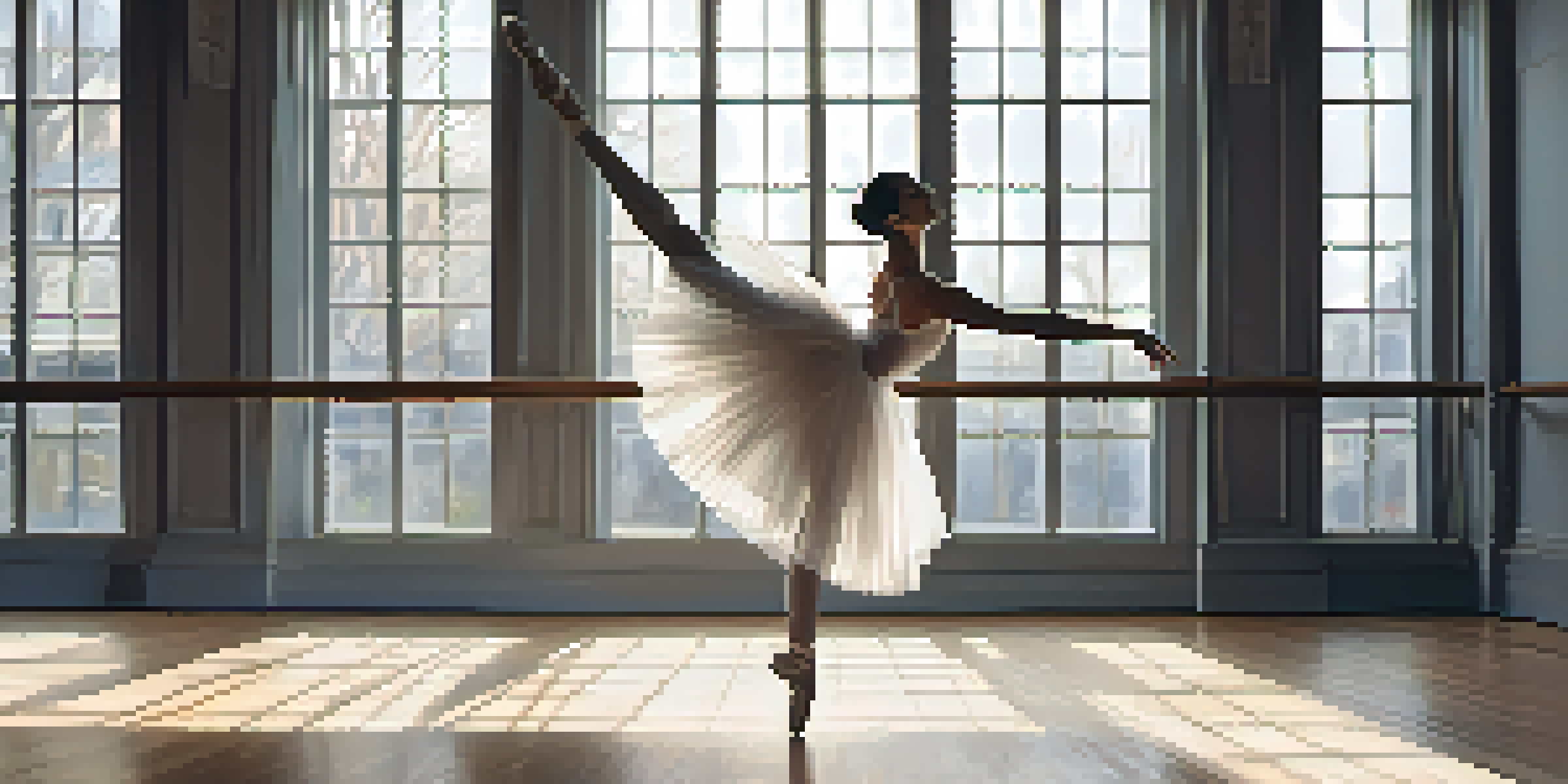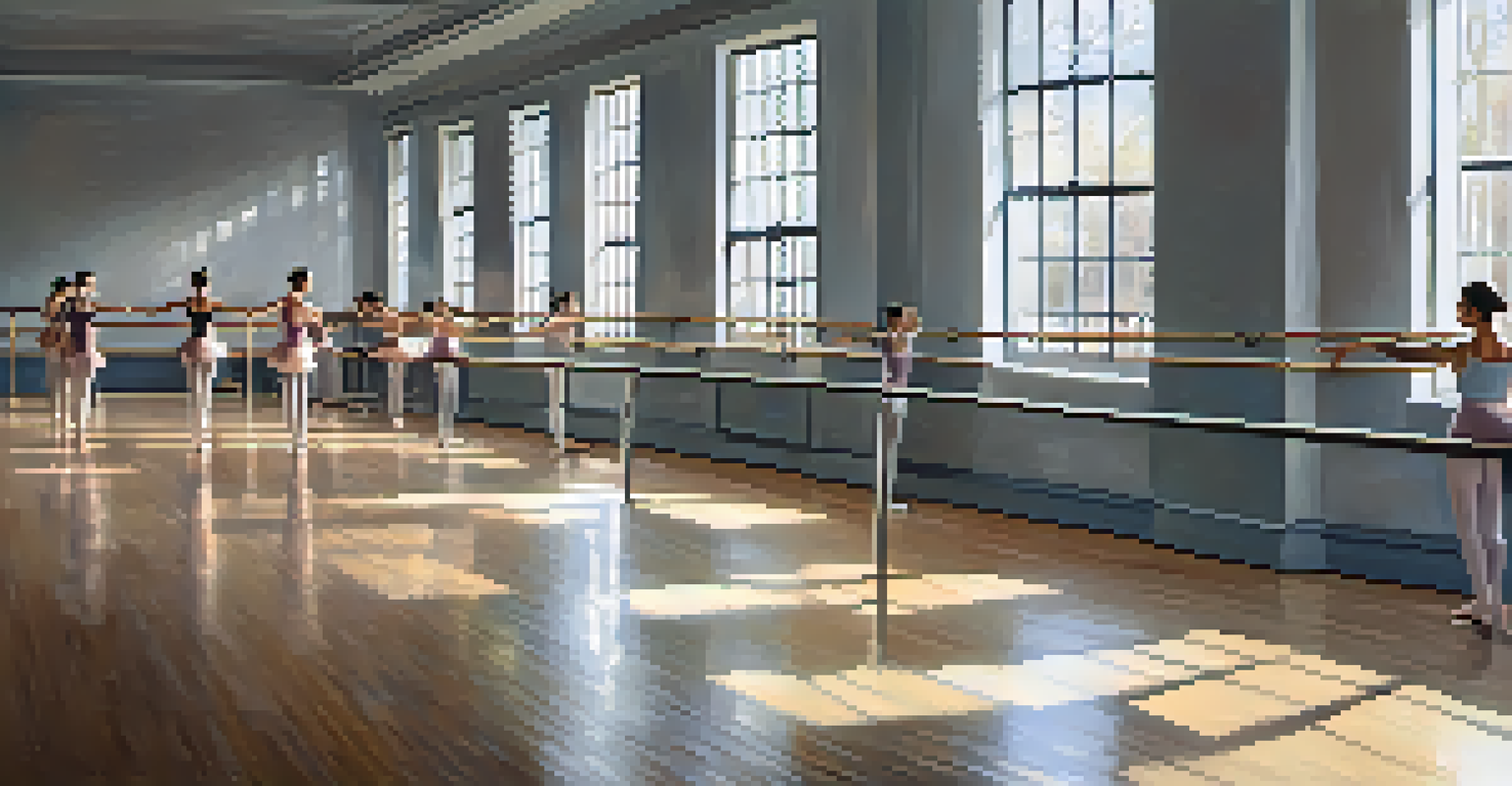Achieving Grace: The Importance of Flexibility in Ballet

Understanding the Role of Flexibility in Ballet
Flexibility is not just a physical attribute; it’s the core of ballet. In ballet, flexibility refers to the ability of muscles and joints to move through their full range of motion. This quality is essential for dancers to achieve the elegant lines and shapes that define the art form.
Flexibility is the key to stability.
Without flexibility, a dancer may struggle to perform movements that require extensions, such as grand jetés or arabesques. Think of flexibility as the foundation of a beautiful sculpture; without it, the final piece may lack the grace and fluidity that captivates audiences.
Moreover, flexibility contributes to injury prevention, allowing dancers to perform demanding routines safely. Thus, it’s vital for dancers to incorporate flexibility training into their daily practice.
The Connection Between Flexibility and Grace
Grace in ballet is often perceived as effortless beauty, but it’s deeply rooted in flexibility. When dancers have the ability to stretch and bend, they can create smooth, flowing movements that enhance their performance. Imagine a swan gliding across a pond; its grace is a result of both its physical attributes and the way it moves.

Flexibility allows dancers to transition seamlessly between poses and movements, making their performances appear fluid. This seamlessness is crucial in ballet, where abrupt movements can disrupt the visual harmony of a dance.
Flexibility is Key in Ballet
Flexibility is essential for dancers to achieve elegant movements and prevent injuries.
Therefore, a flexible dancer can embody the true essence of grace, captivating the audience with every turn and leap.
Types of Flexibility Important for Ballet
In ballet, there are several types of flexibility that dancers focus on: static, dynamic, and functional. Static flexibility refers to the ability to hold a stretch in a fixed position, while dynamic flexibility involves the ability to perform movements that require speed and strength.
The dance is a poem of which each movement is a word.
Functional flexibility is perhaps the most important in ballet, as it combines both static and dynamic elements. This type of flexibility allows dancers to execute movements efficiently and with control, essential for choreography that demands precision.
By understanding these different types of flexibility, dancers can create a balanced training regimen that addresses all aspects of their performance.
Incorporating Flexibility Training into Practice
To achieve the flexibility necessary for ballet, dancers should incorporate specific training routines into their practice. Stretching exercises, such as splits and lunges, can help improve overall flexibility and range of motion. Additionally, dancers can benefit from techniques like yoga or Pilates, which emphasize elongation and control.
Consistency is key; dedicating time each day to flexibility training will yield better results over time. Just like watering a plant, regular attention to flexibility nurtures growth and development.
Grace Relies on Flexibility
A dancer's ability to stretch and bend enhances their grace, allowing for fluid transitions in performances.
Also, it’s important to listen to your body and avoid overstretching, which can lead to injuries. A mindful approach ensures that flexibility training enhances performance without compromising safety.
The Impact of Flexibility on Performance Quality
A dancer’s flexibility not only affects their physical abilities but also plays a crucial role in the overall quality of their performance. When a dancer feels flexible, they tend to express themselves more freely and confidently on stage. This confidence translates into more engaging performances that resonate with the audience.
Moreover, flexibility allows for a greater range of artistic expression. Dancers can explore various styles and techniques, broadening their repertoire and enhancing their versatility.
Ultimately, the combination of flexibility and artistry creates a captivating experience for audiences, making flexibility a cornerstone of ballet performance.
Common Myths About Flexibility in Ballet
There are many myths surrounding flexibility in ballet that can mislead aspiring dancers. One common misconception is that flexibility is solely a genetic trait; while genetics can play a role, training and practice are crucial for developing flexibility.
Another myth is that excessive stretching is always beneficial. In reality, overextending muscles can lead to injuries and long-term issues. It’s important to strike a balance between stretching and strength training to maintain joint stability.
Training for Lifelong Flexibility
Developing flexibility is a continuous journey that requires consistent practice and dedication throughout a dancer's career.
By debunking these myths, dancers can approach their training with a clearer understanding of how to develop flexibility safely and effectively.
The Journey to Flexibility: A Lifelong Commitment
Achieving flexibility is a journey, not a destination. Dancers of all levels must recognize that improving flexibility takes time and patience. Just as a tree grows slowly but surely, dancers must nurture their bodies through consistent practice and dedication.
This commitment to flexibility doesn’t end after reaching a certain level; it’s an ongoing process that evolves with a dancer’s career. As they progress, they will encounter new challenges that require them to adapt and enhance their flexibility continuously.

Ultimately, this lifelong journey is what makes ballet so rewarding, allowing dancers to express their passion and artistry at every stage of their development.